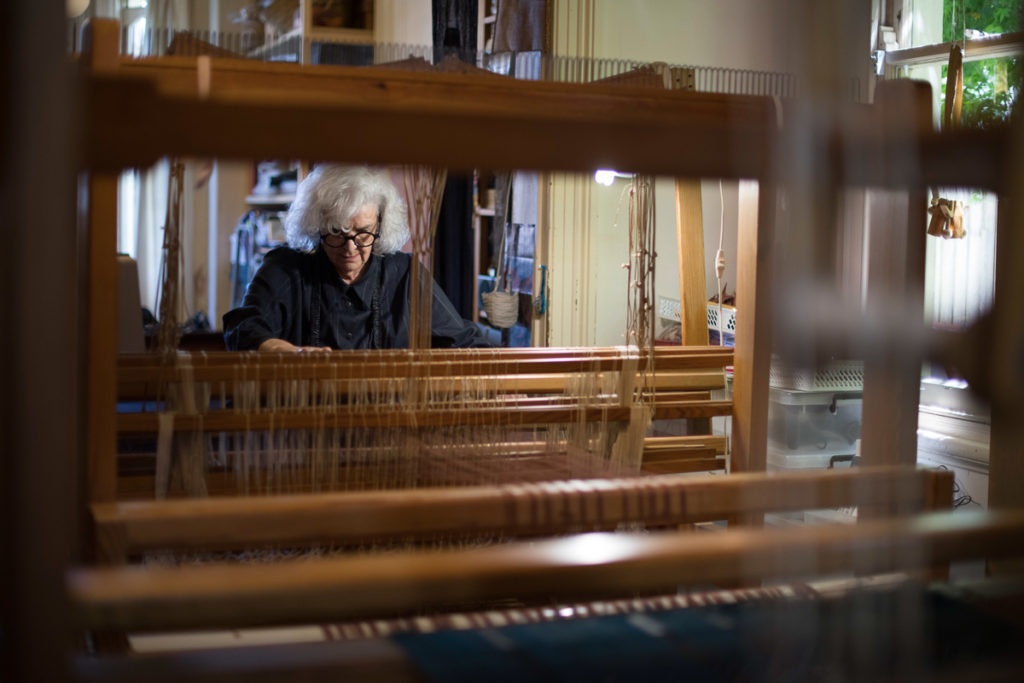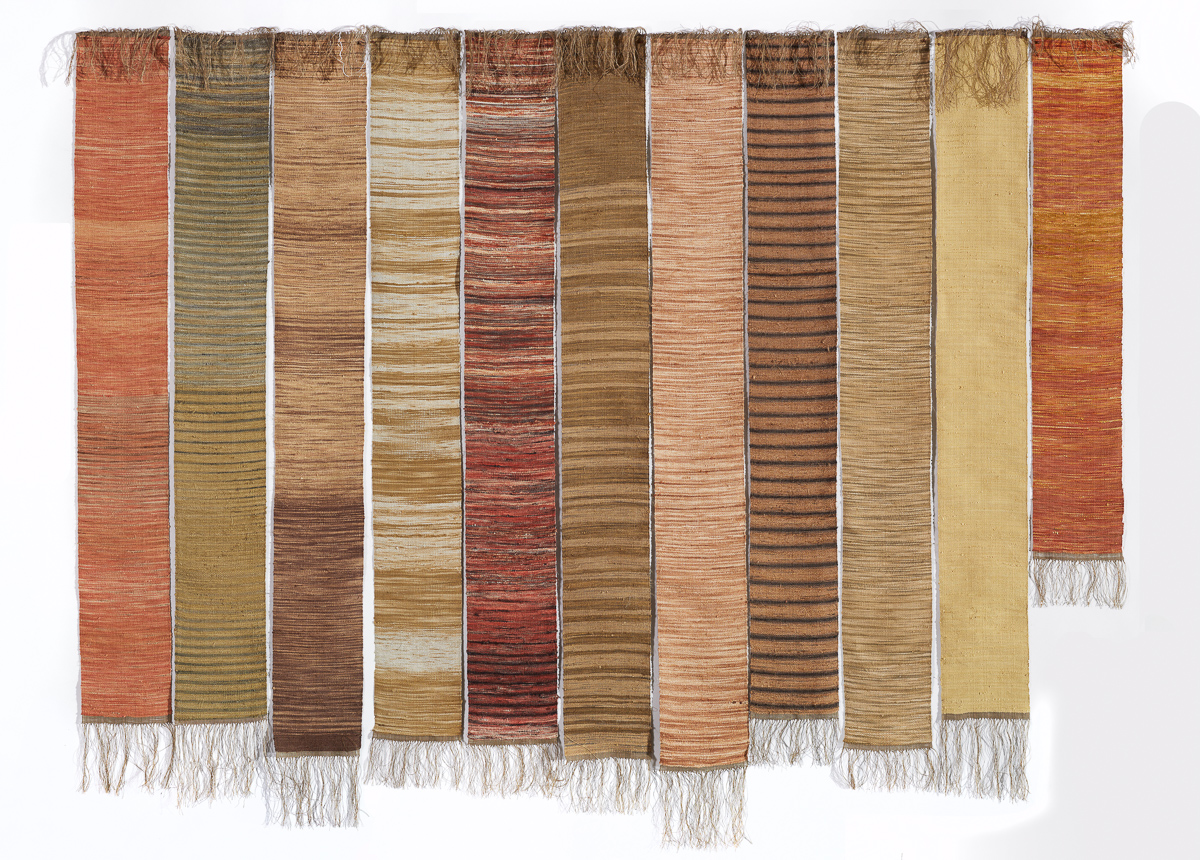Where I work
I work from my studio at my home in the Inner West of Sydney, Australia surrounded by looms, yarns, experiments, weavings, books and collected textiles from my long engagement with weaving and from travels mainly in India. It’s a large studio so there is plenty of space and the view from the window is green from trees I’ve planted over the years.
What inspired my work
Cultural Shadows is a work referencing universal textile-making traditions as it interweaves local colour, cultural connections and weaving traditions. The work represents a community of practise as colleagues in Australia and India have made colour contributions.
Cultural Shadows has evolved from previous projects and research into natural dye experiments in Australia from first settlement in 1788 to now. First settlement was approximately 70 years before Perkin’s discovery of ‘mauve’, the first aniline or chemical dye that led to a widespread shift to synthetic colours around the world. In its first years of settlement, the colony imported the majority of its fabrics, clothing and textiles from India. My engagement with India has been through an interest in weaving, natural dyes and artisan handmade textiles and introducing students and friends to Indian artisans.
In the Australian the idea of ‘making do’ with readily available or locally sourced materials included the ‘wagga’ quilt tradition of piecing together materials as diverse as hessian sacks, animal skins, men’s wool suiting samples or found materials into quilts for warmth, colour and to beautify a simple room. The idea of ‘making do’ underlies the rag rug tradition where ‘new’ items are woven from repurposed or excess fabrics, old clothes or household textiles. In India, ‘making do’ is in so many aspects of daily life. In terms of weaving, small domestic rugs are woven from excess threads and fabric; dhurrie rugs from second hand saris and in West Bengal, yardage woven from strips of fabric woven as weft is called ‘kes’ weaving and used for vests, bags and domestic objects.
Cultural Shadows has been informed by my research into the history of plant dye-making in Australia including Jean Carman, who was the first to systematically document the colours of Australian Eucalypts by testing over 450 species and publishing the results in her book, Dyemaking with Eucalypts in 1978. When reflecting on her dye experiments late in her life, Jean stated that she had found a ‘hidden beauty that was just so unexpected and so rich in the colour tones in eucalypts, wattles and other native plants; a beauty that she ‘never knew …… was hidden away in their leaves’. Jean’s research showed variations in colour related to time, place and climate.
I use the word ‘shadow ‘ in the title of this work to represent the idea that the colour is hidden in the leaves and the idea that plant colours can reveal place and time resonates with the exhibition concept, reflecting on historic connections to settler times, regional relationships and future possibilities.

Dimensions: 16.5cm wide x 92.5cm long; photo: Ian Hobbs
How I made it
In November 2019, I invited Australian and Indian colleagues to participate in my ‘Weaving Eucalyptus Project’ by colouring two metres of silk fabric with leaves from a locally sourced Eucalyptus trees. Once returned to my studio, the coloured silk was ripped into strips between 0.5 to 1cm wide and woven into a warp of fine cotton and linen sewing threads in March and April 2020. Some fabric was dyed in my studio with leaves collected from various locations in Australia and India.
Details of panels 1 to 11 numbered from left.
- Holly Story, Freemantle, Western Australia.
Silk coloured with leaves from Eucalyptus Diversicolour (Karri). Fabric rolled and steamed printed using rain water. Woven panel measures 16 cm x 123 cm.
- Victoria Vijayakumar, Aranya Natural, Munnar, Kerala, India.
Silk coloured with Eucalyptus globulus (Blue Gum) leaves collected by Victoria at Top Station near Munnar in February 2020. Leaves wrapped into silk fabric eco bundles and used to create a dyebath with an alum mordant. Woven panel measures 16 cm x 122.5 cm.
- Santiniketan, West Bengal, India.
Silk coloured with Eucalyptus leaves collected in the Prantik district of Santiniketan in January 2020. From my research, expect these leaves to be Eucalyptus hybrid, a form of Eucalyptus tereticornis known as Mysore gum. Leaves wrapped into silk fabric eco bundles and used for the dyebath; no mordant. Woven panel measures 16 cm x 129 cm.
- Muli, Gujarat, India.
Silk coloured with Eucalyptus leaves collected along a road side in Muli in December 2019. From my research expect leaves to be Eucalyptus hybrid, a form of Eucalyptus tereticornis known as Mysore gum and widely planted in Gujarat in the 1960’s. Silk loosely knotted and dyed with alum as mordant. Woven panel measures 16 cm x 127 cm.
- Stanmore, NSW, Australia.
Silk coloured with leaves from Eucalyptus cinerea (Silver Dollar Gum) and Eucalyptus pilularis (Blackbutt). Leaves wrapped into silk fabric eco bundles and used for the dyebath; no mordant added. Woven panel measured 16 cm x 128 cm.
- Carisbrook, Central Victoria, Australia.
Silk coloured with leaves and bark from Eucalyptus cladocalyx (Sugar Gum). Leaves wrapped into silk fabric eco bundles and used for the dyebath with alum and iron as mordants. Woven panel measures 15.5 cm x 130 cm.
- Julie Ryder, Canberra, Australia.
Silk coloured with leaves from Eucalyptus nicholi (Willow-leaved Peppermint) felled in a summer hailstorm. Fabric tied diagonally in knots and dyed in a stainless steel pot with no mordant. Woven panel measures 16 cm x 132 cm.
- Mary Burgess, Melbourne, Australia.
Silk coloured with leaves and bark from Corymbia citriodora (Lemon-scented gum), a tree in Mary’s garden plus vinegar and rusty iron as additives. Woven panel measures 15.5 cm x 122 cm.
- Sumrasar Sheikh, Kutch, Gujarat, India.
Silk coloured in 2020 with Eucalyptus leaves collected in the grounds of Kala Raksha in December 2019. From my research expect leaves to be Eucalyptus hybrid, a form of Eucalyptus tereticornis known as Mysore gum and widely planted in Gujarat in the 1960’s. Fabric loosely knotted and dyed in dyebath with leaves and alum as mordant. Woven panel measures 16 cm x 128.5 cm.
- Judith Kentish, Kobble Creek, Australia.
Silk coloured with fresh leaves from Eucalyptus acmenoides (White Mahogany) plus an alum mordant. Drought impacted on the resultant colour giving a clearer yellow. Woven panel measures 16 cm x 124 cm.
- Ro Cook, Lilyfield, NSW, Australia.
Silk coloured with Eucalyptus cinerea (Silver Dollar Gum) and Eucalyptus sideroxylon rosea (Red Ironbark) leaves in an eco-print using a small amount of alum. Woven panel measures 16 cm x 94 cm.
Where the botanical name of the Eucalypts is known, it’s given along with the common name in brackets. In India, identifying specific Eucalypts is challenging; the only tree named from those collected was Blue Gum in Kerala; other names are sourced from research into botanical documents.
What I am working on
The current Cultural Shadows installation comprises eleven panels but the Weaving Eucalyptus will continue as the community of practitioners involved with dyeing with Eucalypts is growing; I’m also collecting leaves from places I visit and with many flowering trees and shrubs known as Eucalyptus that can be sourced locally, the Weaving Eucalyptus project will continue.
Biography

I’ve has been weaving since the late 1970s and am still fascinated with the process and potential of interlacing two sets of threads on a loom. My practice is diverse: designing for industry; exhibition artwork; production weaving of wraps and scarves in my Sydney studio; teaching weaving workshops nationally and internationally; and more recently engaged with artisan groups in India and organizing ‘Cultural Textiles’ tours in Gujarat and West Bengal. At the heart of my practice, is an interest in innovative, experimental and unusual designs created at the loom. I’m also involved in education being Associate Professor at UNSW Art & Design, University of New South Wales, Sydney, Australia.
Instagram: lizwilliamsonweaver

